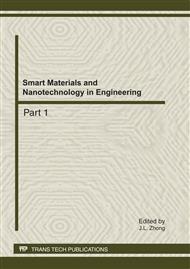p.104
p.113
p.119
p.124
p.128
p.134
p.139
p.147
p.154
Reagentless near-Infrared Determination of Cholesterol in Undiluted Human Serum Using Interval Partial Least Square
Abstract:
In order to determination of cholesterol in human serum with no reagent using near-infrared (NIR) spectroscopy. Interval partial least square (iPLS) was proposed as an effective variable selection approach for multivariate calibration. For this purpose, an independent sample set was employed to evaluate the prediction ability of the resulting model. The spectrum was split into different interval. Then, the informative region of cholesterol (1688-1760nm), in which the PLS model has a low RMSEP with 0.241mmol/L and a high R with 0.975, is selected with 23 intervals. The results indicate that, the informative region of cholesterol can be obtained by iPLS and applied to design the simpler reagentless NIR instruments for inexpensive cholesterol measurement in future.
Info:
Periodical:
Pages:
128-133
Citation:
Online since:
September 2011
Authors:
Keywords:
Price:
Сopyright:
© 2012 Trans Tech Publications Ltd. All Rights Reserved
Share:
Citation:


